MXA RETRO TEST: COMPLETE TEST OF THE 2001 KTM 250SX
 This article is from the December 2000 issue of Motocross Action Magazine. Get your MXA subscription today
This article is from the December 2000 issue of Motocross Action Magazine. Get your MXA subscription today
QUESTION ONE: IS THE ‘01 ENGINE FASTER THAN THE ‘00?
Yes! It would be impossible for it not to be. Last year’s engine had a lazy powerband that begged for an odometer and route chart. With the exception of a little burp of power when rolling the throttle on, there wasn’t much to rave about on the 2000 KTM 250SX. It had a short, flat, monotone-style of power. The 2001 KTM 250SX is lightyears better than the 2000.
QUESTION TWO: WHAT DID KTM CHANGE ON THE ‘01 ENGINE?
In truth, they had changed almost every part of the engine for 2000, so they really didn’t have to make very many changes. Yet, that is confusing. If the 2000 engine was a dog, why wouldn’t KTM change every aspect of it. The reason is simple. Last year’s engine suffered from a serious lack of development. KTM rushed the all-new engine into production without dialing in the porting, jetting, head volume or ignition curve. It wasn’t ready.
Now, a year later, they have had the luxury of time to finish the R&D they skipped (or did poorly) last year. So what did they change for 2001? Three little things: (1) They reshaped the exhaust and boost exhaust ports. (2) The head volume was reduced for crisper throttle response. (3) The piston has been lightened.
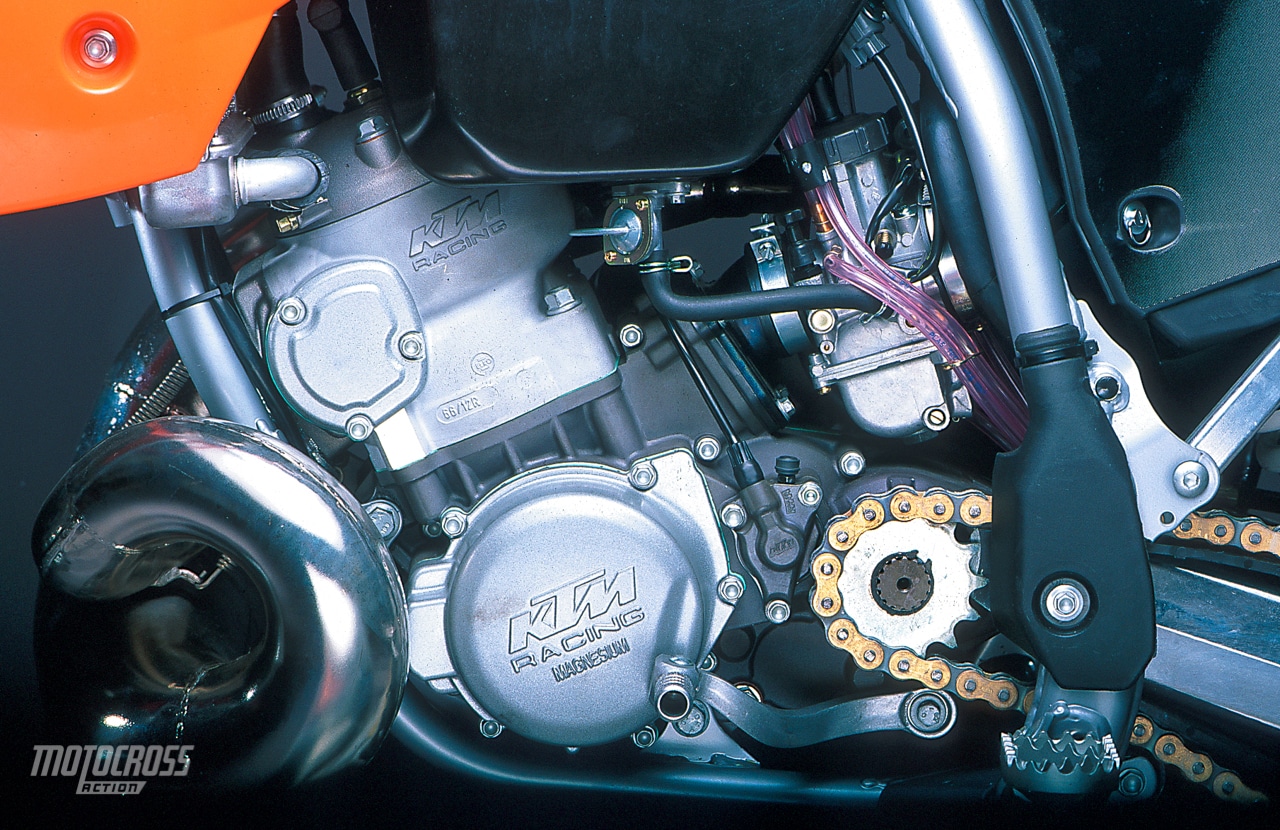
QUESTION THREE: WHAT DO THE CHANGES MEAN?
The 2001 KTM 250SX has a great engine. It produces significantly better power than last year. The 2001 Austrian engine has a broader power spread, is easier to ride and carries momentum from gear to gear with aplomb. Every test rider loved the way the engine ran. It required less clutch work than any 250 two-stroke in recent memory.
QUESTION FOUR: IS IT AS FAST AS A JAPANESE 250?
You bet! Not only is it as fast as a Japanese 250, it has a better engine than most.

QUESTION FIVE: WHAT ABOUT THE JETTING?
Here is the jetting we ran in our 2001 KTM 250SX.
Mainjet: 172
Pilot jet: 48
Needle: NOZF NOZE
Slide: 6.0
Air screw: 1 1/2?
Clip: groove number 4th
QUESTION SIX: WHAT ABOUT THE HYDRAULIC CLUTCH?
Hydraulic clutches are the wave of the future. As of now they only come on European motocross bikes, but, with the exception of Honda, every Japanese bike needs remedial clutch help (especially Suzuki). Don’t get too misty about hydraulic clutches though. They don’t do what most people think they do. If you suppose that hydraulic clutches are easier to pull than regular clutches, you are wrong. They aren’t. If you presume that they feel better than a manual clutch, you are wrong. In truth, a hydraulic clutch is a little firmer than the smoothest of the standard clutches and it has a distinctly different feel. But, they make the clutch plates last longer—which is a great thing.
What a hydraulic clutch does offer is a consistent feel over a long moto. It resists the temptation to go slack, get mushy or tighten up. Although not totally immune to lever pressure variations, hydraulic clutches are more consistent than most manual clutches (with the possible exception of a CR clutch). Sweet, very sweet.
QUESTION SEVEN: WHAT ABOUT THE SINGLE-SIDED, NO-LINK REAR END?
Single-sided, no-link rear suspension systems should be the wave of the future (although since you have to go back to the1983 ATK to see the first one it hasn’t been a slam dunk). In truth, notorcycles don’t have to have complicated linkages, pivots, bearings and pull rods to achieve the necessary leverage ratio change. By positioning the shock within the known framework of a scalene triangle (one in which the sides have different lengths and angles) a suspension designer can duplicate the rising rate of any linkage system. Single-sided shock systems are less complex, have fewer moving parts, weigh approximately seven pounds less (important on a four-stroke) and are accessible. Perhaps the biggest advantage, and one that has nothing to do with the rear suspension, is that one-sided shocks make room for a straighter carburetor tract (which means more horsepower). The big disadvantage is that shock technology hasn’t addressed the needs of single-side shocks as well as they have linkage equipped shocks.
QUESTION EIGHT: HOW GOOD IS THE 250SX REAR SUSPENSION?
KTM has made steady strides in dialing in their one-sided rear suspension system. Although they have made no changes to the shock position over the last three years, they have completely renovated the WP-built, but Ohlins-licensed, shock. The original idea of the PDS shock was to have two shock pistons that interacted at different points in the rear wheel’s travel. One piston would be position-sensitive and the other speed-sensitive. Great idea in theory, but absolutely atrocious in action. To KTM’s credit, they have been reducing the effect of the second piston with each successive year, to the point that it is now used to control bottoming only. Additionally, the WP rebound circuit has been revised so that a needle replaces the previous valve (this is supposed to reduce thermal loads on the piston). The rear of the KTM has a harsh feeling when new, but as it breaks in it begins to feel better. We had decent luck with the stock shock spring this year.
What was our best shock setting?
Spring rate: 8.3/ 11 kg/mm?
Race sag: 95mm
Compression: 4 clicks out
Rebound: 20 clicks out
Notes: Common sense and years of experience tell a rider that turning the compression clicker in (clockwise) will stiffen the compression damping. Not so on a KTM. You turn the clicker out for more compression and in for less.
QUESTION NINE: WHAT DO WE THINK OF THE 2001 WP FORKS?
We think they are terrible. We were a little miffed that KTM threw in the towel on its right-side-up forks in 2000, but we kept an open mind. We should have closed it. The upside-down WP forks need help. The 2001 forks aren’t supple. They are too soft. Even worse, they bottom and then bounce. The damping and spring rate are poorly matched. The quickest fix for these forks is to drop the stock 0.40 forks springs for stiffer 0.42kg/mm springs. Additionally, we lowered the oil height from 130mm to 140 (which is where it was last year).
What was our best setting? For hardcore racing we recommend this set-up:
Spring rate: 0.42kg/mm (0.40 kg/mm stock)
Oil height: 140mm (130mm stock)
Compression: 14 clicks out
Rebound: 14 clicks out
Fork leg height: 10mm above triple clamp
Notes: Unlike last year’s conventional forks, which had way weird adjuster placement, the new WP upside-down forks mimic Kayabas (compression on the bottom and rebound on the top).

QUESTION TEN: HOW DOES IT HANDLE?
The phrase “Italian handling” is not a compliment. Since the KTM is built in Austria, it can’t be accused of having Italian handling, however, at best it has “Common Market handling.” And, what exactly is Italian handling? It describes a bike that goes well in a straight line, likes to slide around wide open corners and is effective in sweepers. However, an Italian bike (nee’ Austrian bike) is harder to turn than a locomotive.
KTM handling is an area that can’t be danced around. The Austrian bike does not handle like a Japanese motocross bike. This is most noticeable on tight, twisty tracks, but is equally evident in any sharp corner. It doesn’t turn as quickly as an RM, YZ, CR or KX. It’s better to slide the corners, seek the outside line and try to maintain momentum.
Strangely, the lighter KTM 125SX and heavier KTM 520SX handle much better than the 250SX. The 2001 250SX has a big push in the front end that needs to be fixed.
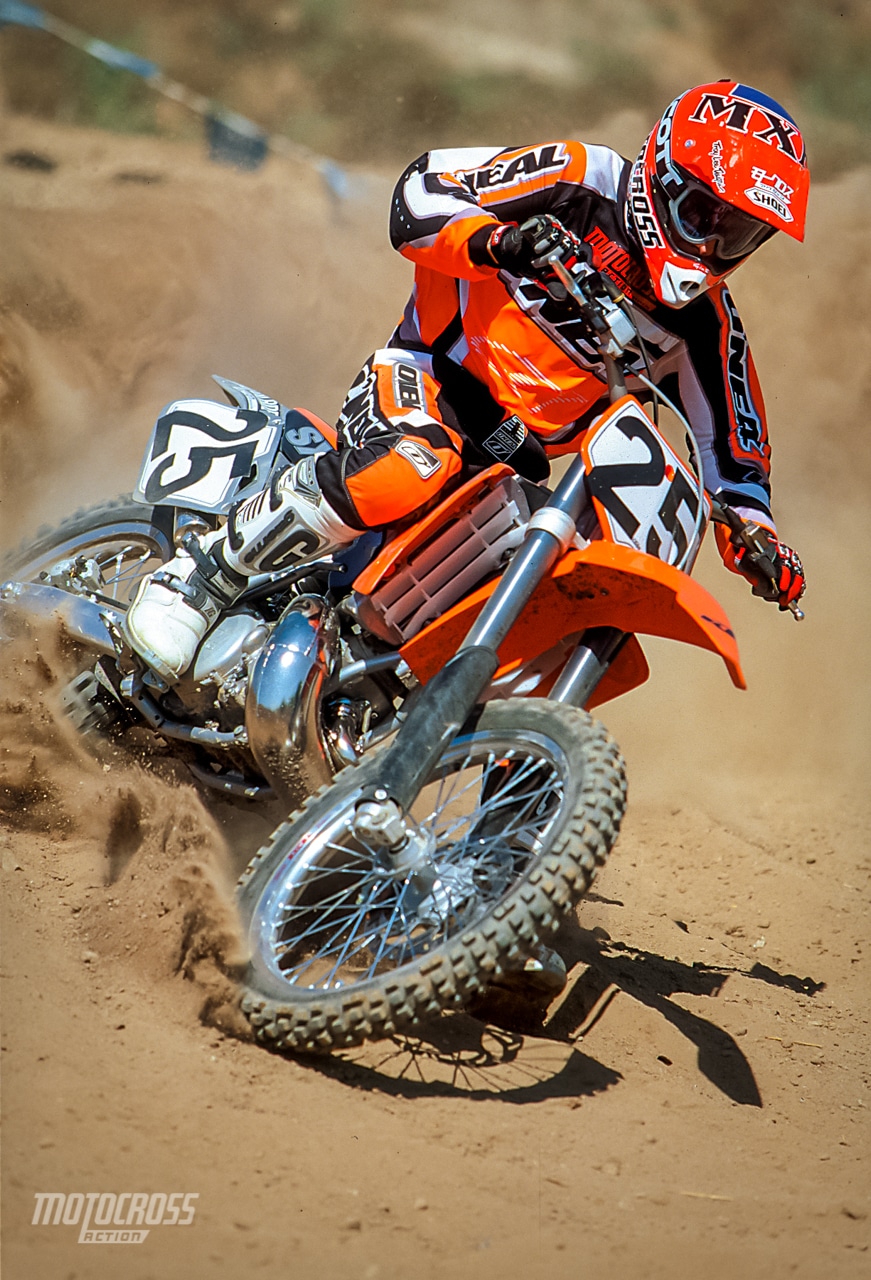
QUESTION 11: WHAT ABOUT THE NEW GAS TANK?
The best thing that KTM did to the 2001 KTM was redesign the gas tank. The new unit is slimmer, sleeker and narrower than any tank made. It makes moving around on the KTM easier. On the downside, we would have liked a larger gas cap and orange plastic. The combination of a teeny little inlet and dark plastic eliminates any hope of knowing if the gas tank is full or not. This is a fill-it until you spill-it gas tank.
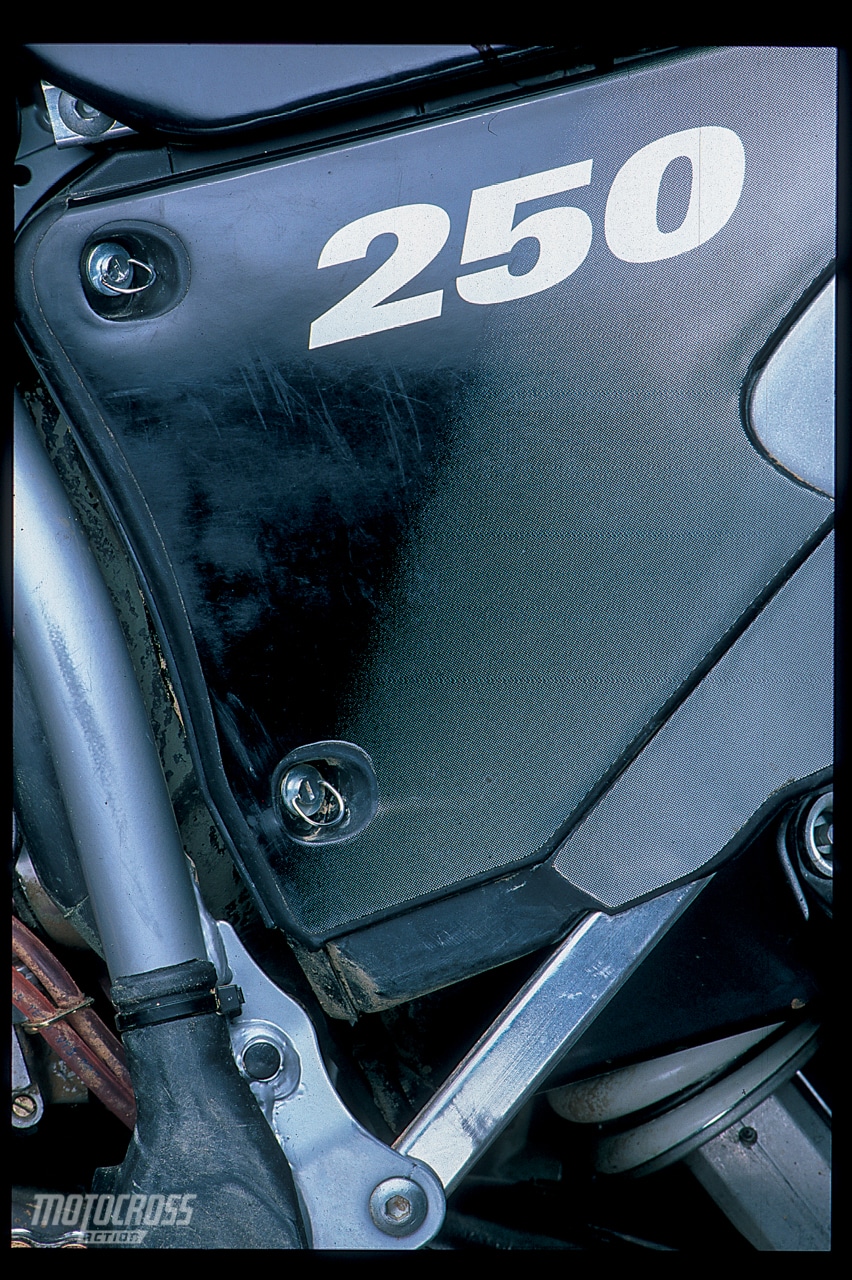
QUESTION 12: WHAT DID WE HATE?
The hate list:
(1) Front fender: KTM’s front fender looks awful.
(2) Gas cap: The gas cap is too small.
(3) Rear brake: KTM claimed that they changed the rear brake to make it more progressive. We have no doubt that they changed it, but it isn’t more progressive. It squeals and squeaks like a pig.
(4) Compression adjuster: Some test riders would accidently turn the WP compression adjuster with their boot. The bike got stiffer as the moto got longer.

QUESTION 13: WHAT DID WE LIKE?
The like list:
(1) Airbox: It’s cool not to have to remove the seat to get to the filter. Watch the dzus-style fasteners—they disappear faster than David Copperfield.
(2) Handlebars: KTM is the only one of the Big Five to come stock with aluminum handlebars…let alone over-size aluminum bars. Very cool.
(3) Frame guards: KTM includes plastic frame guards on every bike.
(4) Preload ring: Instead of using two rings, which lock against each other, KTM has a very thick single ring which clamps to the shock body via an Allen bolt. This is a good idea and makes adjusting spring preload easier.
(5) Clutch: It’s hydraulic. Enough said.
(6) Chain adjuster: KTM designed eccentric chain adjuster blocks that can be turned around when the chain stretches. Additionally, they have a very long axle slot to accommodate massive wheelbase changes.
(7) Bar mounts: KTM’s triple clamp features four-way adjustable bar mounts. This allows the rider to fine tune the fit. We ran the bars all the way forward
(8) Details: The KTM bristles with creative extras. The motor mount nuts are caged so that you don’t need a wrench to hold them. The axle nuts are capped so that the threads aren’t exposed. The brake rotors are cauliflower-shaped to equalize heat. The chain blocks are eccentric so that you can change the wheelbase.
(9) Swingarm: Previous KTM swingarms broke. The 2001 KTM has a totally new, one-piece, extruded swingarm.
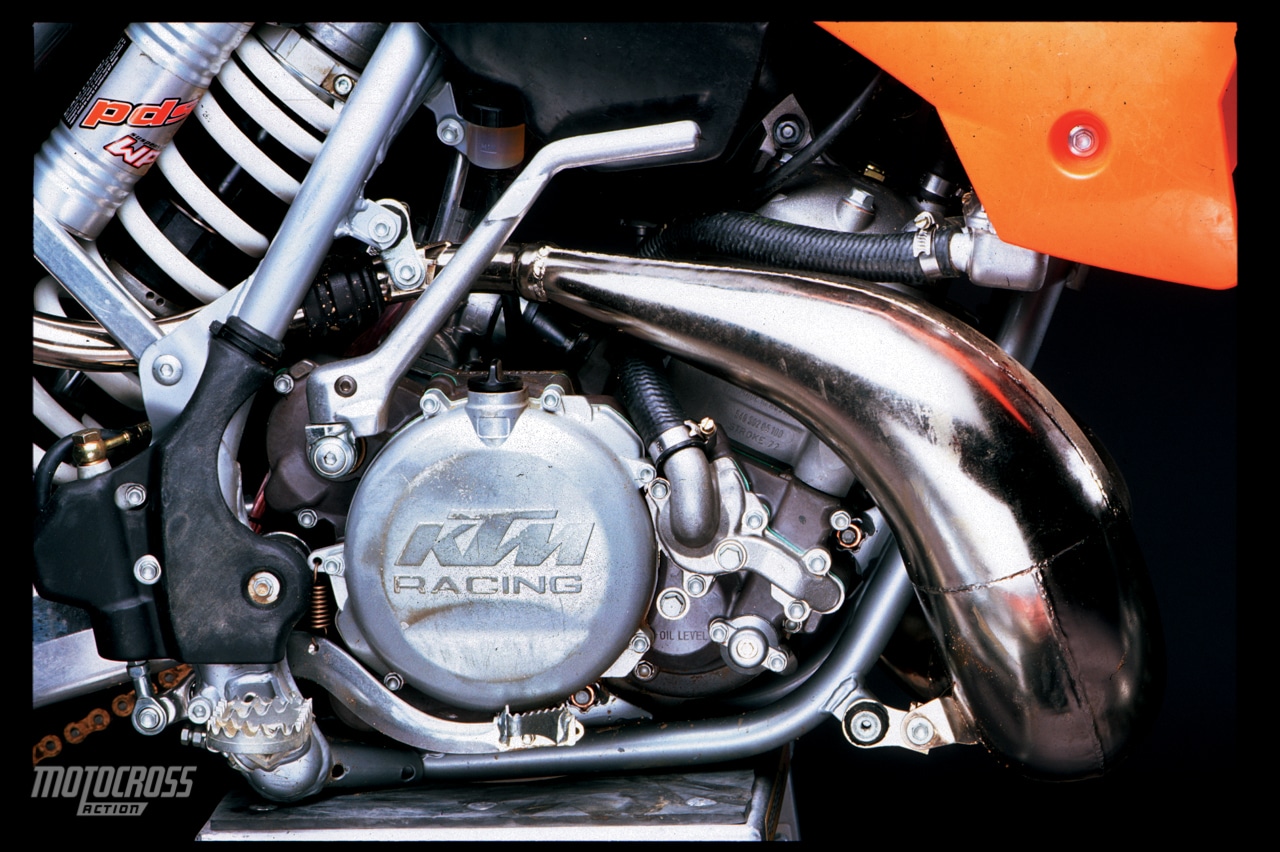
QUESTION 15: WHAT DO WE REALLY THINK?
Last year the KTM 250SX had “Euro handling and enduro power.” This year, it has an awesome engine…now, if only we could do something about the cornering.


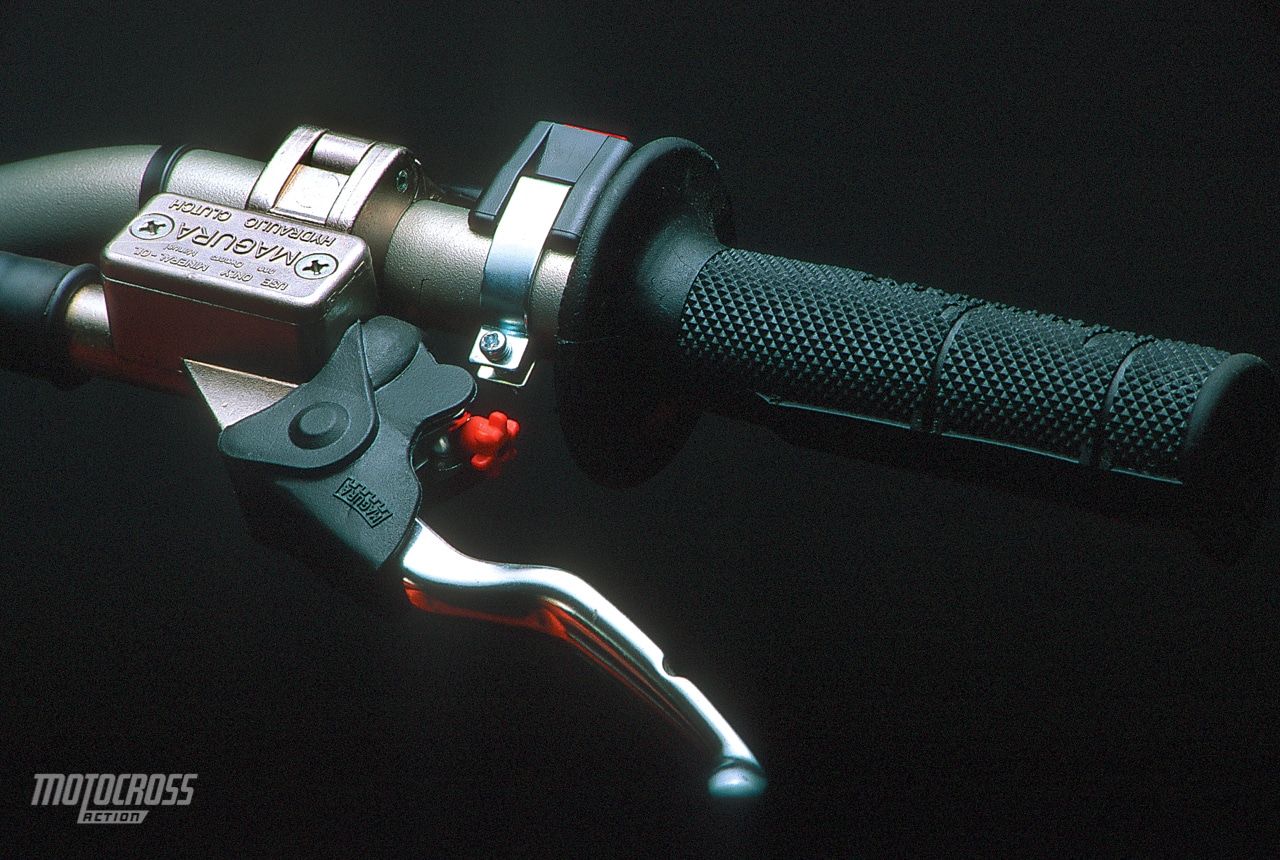
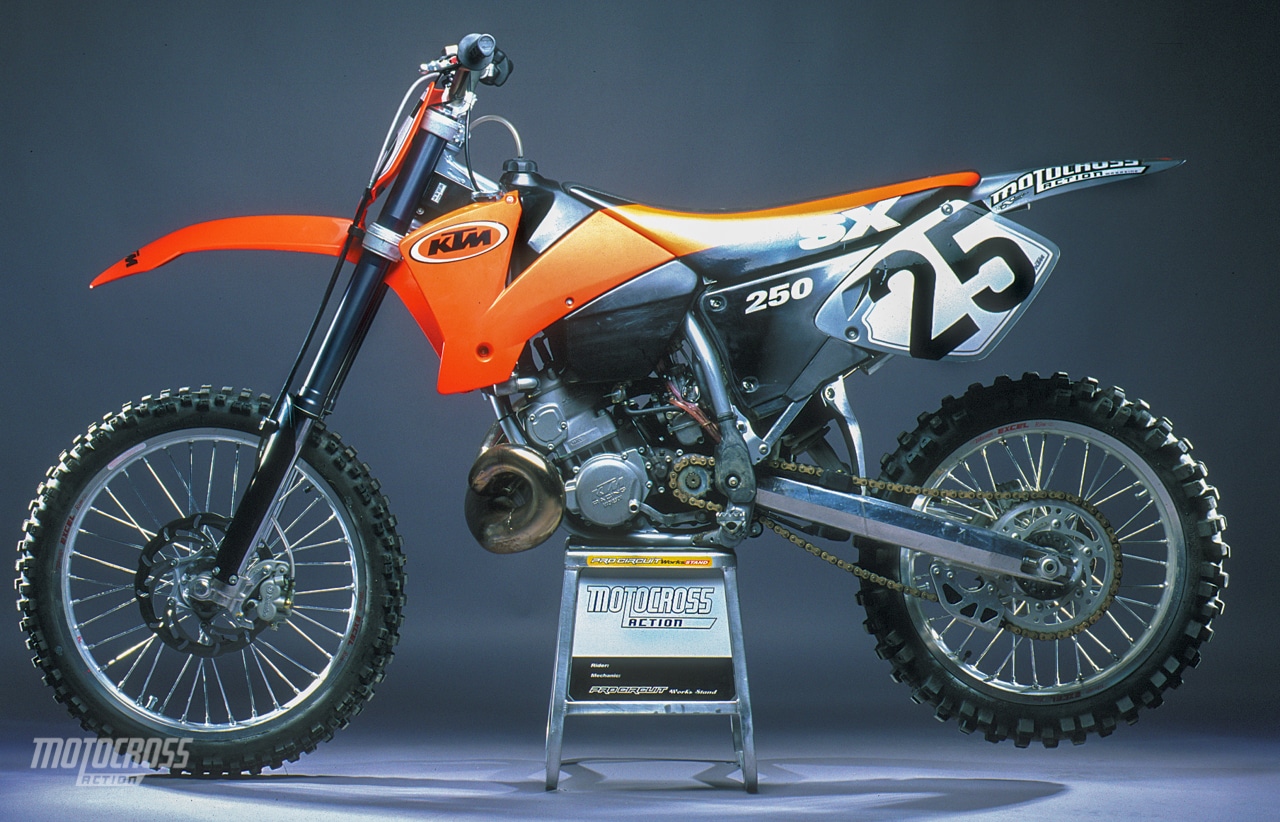




Comments are closed.